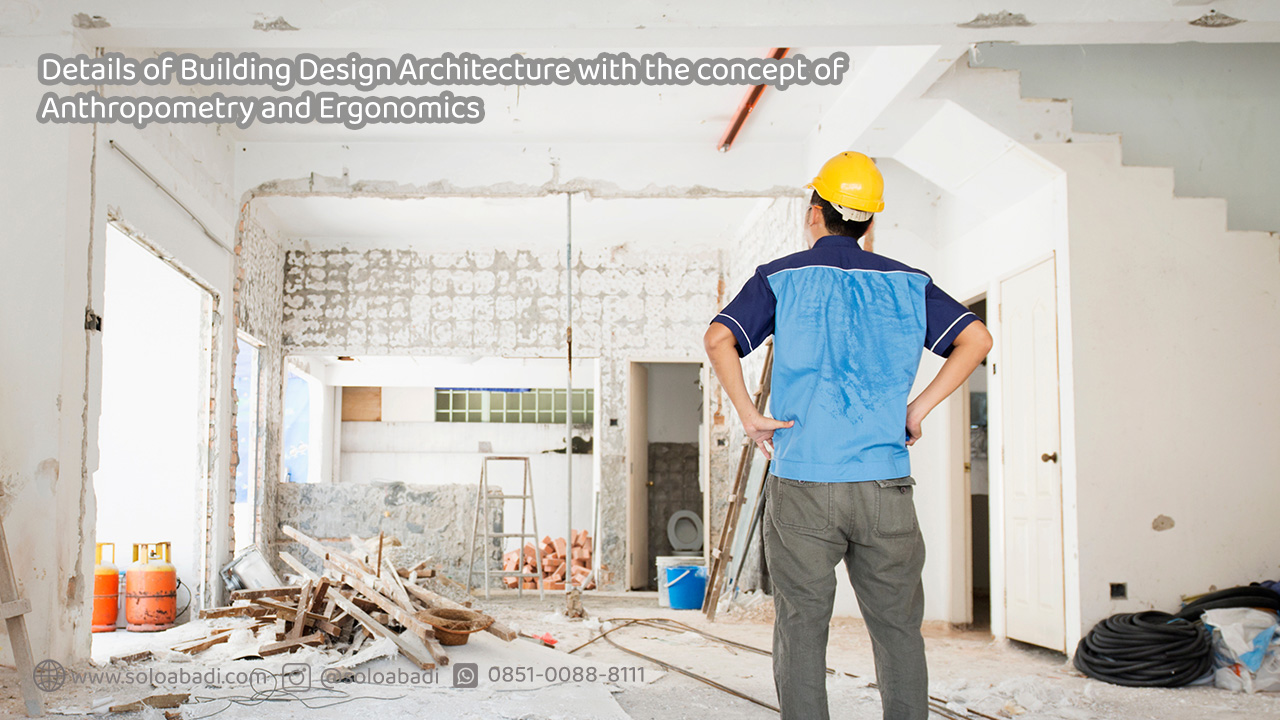We all already know that architectural design in making a building, residence, and building will have an important role in the manufacturing process. Architectural design at this time has developed by applying a design that is quite complex and unique to be more attractive and not bored to the eye. But do friends also know that in making architectural design is not only the factor of beauty and uniqueness that determines the formation of a design but many factors that influence and support the process
Therefore, an architect is required to be able to consider and think about architectural concepts from various factors. One of the factors that become an important point in determining architectural design is related to comfort or better known as anthropometry and ergonomics.
Architectural design details that use the concepts of anthropometry and ergonomics will also greatly affect the success and failure of a building. This is very related to the process of how to build, maintain, the layout of the room, as well as the comfort and accuracy of positions that will affect the comfort in the use of the building.
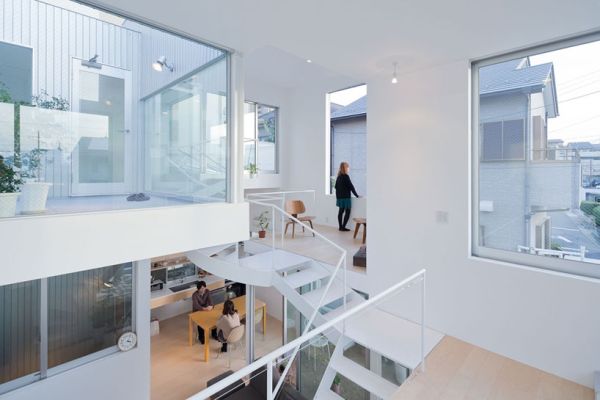
How to detail the design of a good building concept and its relationship with Anthropometry
In the science of design (design) for Architecture, especially rooms or buildings applying the science of Anthropometry is very useful to create a room that is truly ergonomic for its occupants. Thus the comfort of space will increase and the function of the space can be more optimal.
The detail in architecture can increase the value of the building by providing convenience in building and maintaining the building. This can be achieved with deeper thinking without compromising the aesthetic and functional value of the object to be detailed.
This is what became known as anthropometry. In other words, these anthropometrics are factors that affect the comfort of the user/owner of architectural results, which are realized in a building. It can be material selection, aesthetic value, mechanical and also electrical, structural strength, utility function, and others.
Factors included in architectural design:
1. Building Design/Drawing
The first thing to do in the construction of a building/house/building is the creation of a design/drawing of a building design. From this image/design will be seen several things related to the details of this architectural design.
Whether it is in the form of building shapes, building materials, electrical systems, and others, which are adjusted to the strength of the building structure and also the aesthetic value that is deliberately embedded in the building/house.
The design/drawing of the building is carried out by a drafter on the instructions of an architect. Only then, after the architectural design has been completed, an architect will apply the design drawings in real form, by conducting orders and supervising all project workers.
2. Material Selection
The second step that can be done in the process of architectural detail is the selection of materials. Some materials used must certainly have strong standards, be durable, and have good aesthetic value.
In a sense, when the building has been built, it should be sturdy, strong, and durable. But it also has beautiful aesthetic value and is interesting to look at. Things that affect all of that of course, of them, come from the material used.
3. Structural Strength
As discussed earlier, a building should be sturdy and strong. In a sense, the building can withstand strong winds, tremors such as earthquakes, and others.
To get a sturdy and strong building, of course, in addition to relying on the selection of the right materials, it is also influenced by the strength of the structure applied to the building. As for the task of making a design and also the construction of a building related to the strength of the structure, it is certainly the responsibility of an architect.
4. Utility Function
A building certainly has different functions (utility functions). Be it buildings intended for industrial areas, offices, schools, hospitals, and residential homes. Therefore, an architect is required to understand the utility function of the building to be built.
5. Mechanics and Also Electricity
In addition to the above factors, an architect should also think about the electrical system that will be used in the building. Because of course, a building that is not equipped with a source of lighting can be considered a failed building.
6. Aesthetic Value
Along with the times, aesthetic value is also an important factor that needs to be considered. The aesthetic value referred to here is the value of art, and also things related to other elements of beauty. Where in this architectural detail, aesthetic value or art value / and element of beauty is as important as the strength of the structure, the function of utility, and also the selection of materials in a building.
Its application can be seen in the arrangement of space (layout), furniture arrangement, and the shape or design of furniture to be made. If a room or furniture is not ergonomic then no matter how beautiful the design will feel less functional.
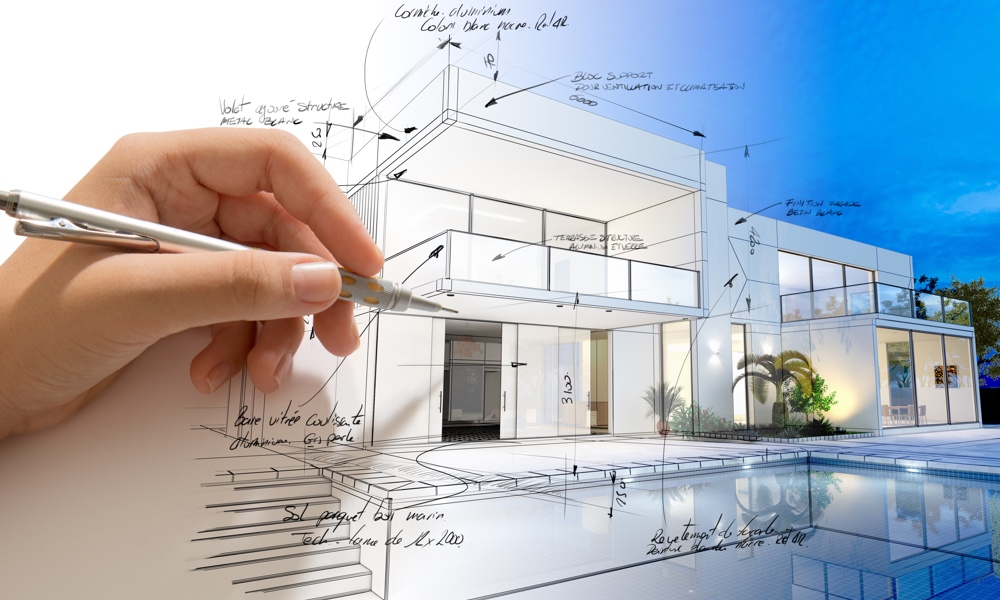
Anthropometric and Ergonomic Measurements as Guidelines for Determining Building Design
Anthropometry affects a wide range of industries, processes, services, and products and has a major influence on optimizing building design. Human dimensions and capabilities are key factors in determining the proportion and overall design of a building. The basic principle of anthropometry is that the design of buildings must correspond to the human body, there is no concept that people should fit into buildings.
There are two main areas of anthropometry:
- Static anthropometry (Ergonomics) is the measurement of body size at rest and when using furniture & devices such as chairs, tables, beds, mobility devices, etc.
- Functional anthropometry is the measurement of capabilities associated with movement tasks, such as achieving, maneuvering, and moving, and other aspects of the use of space and equipment.
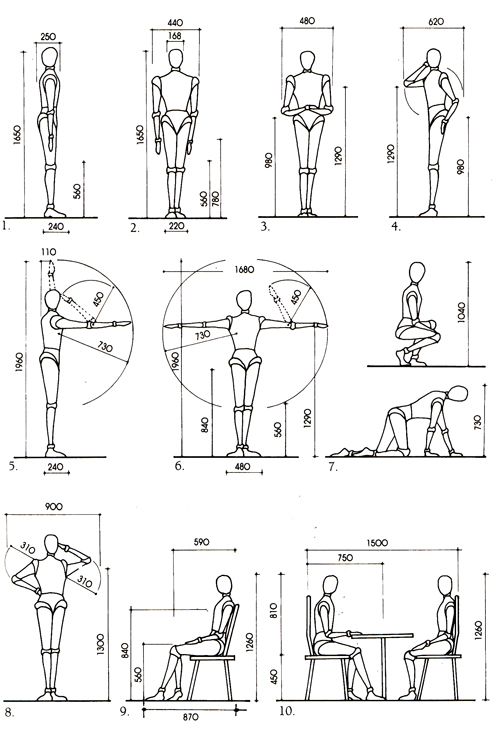
Anthropometry in building design aims to ensure that every building user can live as comfortably as possible. Practically speaking, this means that the dimensions should be appropriate, the ceiling is quite high, the doors and passages are wide enough, and so on. In some cases, this has a special meaning for workplace design.
Anthropometry provides a variety of standard requirements and approved solutions for designers to help ensure appropriate design. However, it is important to consider the specific goals and needs of the user.
Anthropometry also has an impact on the need for space for furniture and equipment, for example:
- The bedroom should have enough space to comfortably install the necessary furniture.
- The bathroom should have enough space to fit the bath accessories comfortably
- The distance and height of the stairs must be for the comfort and safety of the user
- The office building must have enough space to fit the needs of workers in the office.
- The kitchen must have proper circulation and spacing between furniture to facilitate its users.
So, Anthropometry helps to find the minimum standard dimensions that humans need to fit in a particular work area and perform routine activities ergonomically and efficiently.
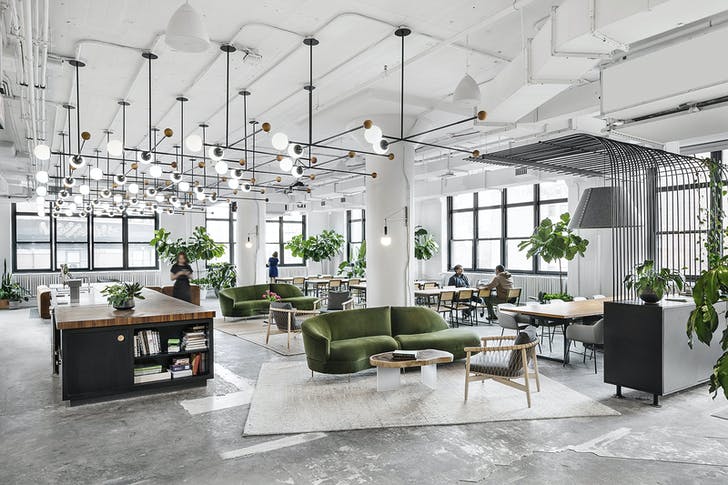
What do you need to determine ergonomics?
Anthropometric measuring instruments are one of the important components in determining the level of ergonomics of a building because the architectural design made will be implemented in a building, room, or building which will certainly be used by humans in daily activities.
Anthropometry was developed as a method applied by physical anthropologists to study the size of the human body. In particular, anthropometric measurements involve the following:
- Size (e.g., height, weight, area, and volume),
- Structure (e.g. Height, width, length of various parts of the body), and
- Composition (e.g., percentage of body fat, water content, and body mass) of humans.
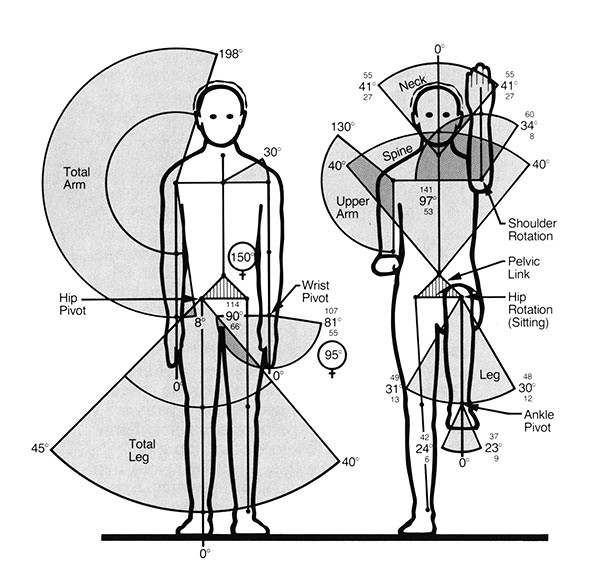
Various special tools (as described below) are used to obtain anthropometric measurements:
- Stadiometer: height
- Anthropometer: length and circumference of body segments
- Bicondylar caliper: bone diameter
- Skinfold calipers: skin thickness and subcutaneous fat
- Scales: weight
Solo Abadi Best Atropometric Measuring Instrument Manufacturer in Indonesia
The design of a house, building, or dream room that is comfortable and also beautiful is everyone’s dream, but behind it, many things greatly influence the process of making it.
The main challenge facing architects, who are trying to apply anthropometry to building architecture, is related to the dimensional data of the human body. This is mainly because the size of the human body varies according to age, gender, race, and even socioeconomic factors; The measurements taken also vary. In addition, these measurements are not only static but also dynamic – so architects need to have body dimension data when a person moves, performs activities, or participates in work. Body size varies according to the functions we perform. There are differences in the dimensions of the way we sit, stand, or perform any activity.
If you are interested in taking anthropometric measurements for architectural needs. Then the use of appropriate measuring instruments can help the work process easier. We provide modern and easy-to-use anthropometric measuring instruments, namely anthropometric chairs and portable anthropometry kits.

